Which of the Winless NFL Teams Can Still Save Their Season?

Since 2020, 18 teams have started the season 0–2 and none of them have made the playoffs. This statistic—if we can legitimately call something with that small of a sample size a statistic—was surprising in that we typically don’t consider a winless streak as consequential until a loss the following week. Before the onset of the 17-game regular season, anyone following an NFL team was well aware that an 0–3 mark doomed a season (only six teams in modern NFL history reached the postseason after losing their first three). The healthy sample size offered a high degree of certainty. As for an 0–4 start, it was down to just the 1992 San Diego Chargers, the only team to traverse that deficit and make the playoffs. Four losses to start a season suggested that teams’ playoff chances were virtually nonexistent.
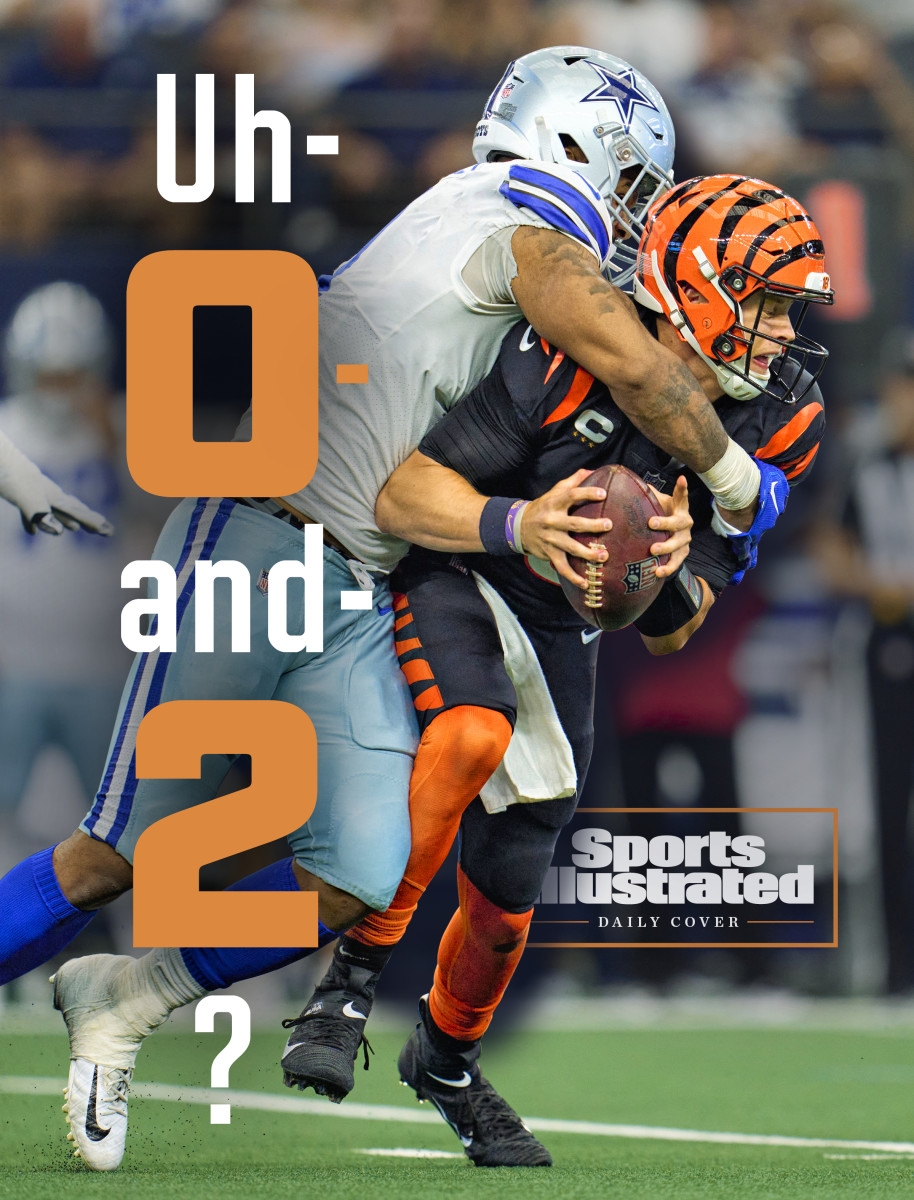
We can start this column with a bold prediction: At least one 0–2 team on this list will make the playoffs in 2022. The list of quarterbacks and coaches down below is simply too good. Some of these teams started the season with difficult schedules or are working out some schematic kinks (which we’ll get to). While the AFC teams will have a harder road given the depth of talent in the conference, we’re more than confident in saying a few suspect 1–1 or 2–0 teams won’t be relevant by Halloween.
So, as we like to do every year around this time, let’s attempt to find some clarity among the chaos and run through the winless teams. Should they be hitting the panic button? If the answer is yes, fear not—we have a growing library of assembled mock drafts you can peruse.
BENGALS
Week 1: 23–20 (OT) vs. Pittsburgh
Week 2: 20–17 at Dallas
Time to Panic? Not yet
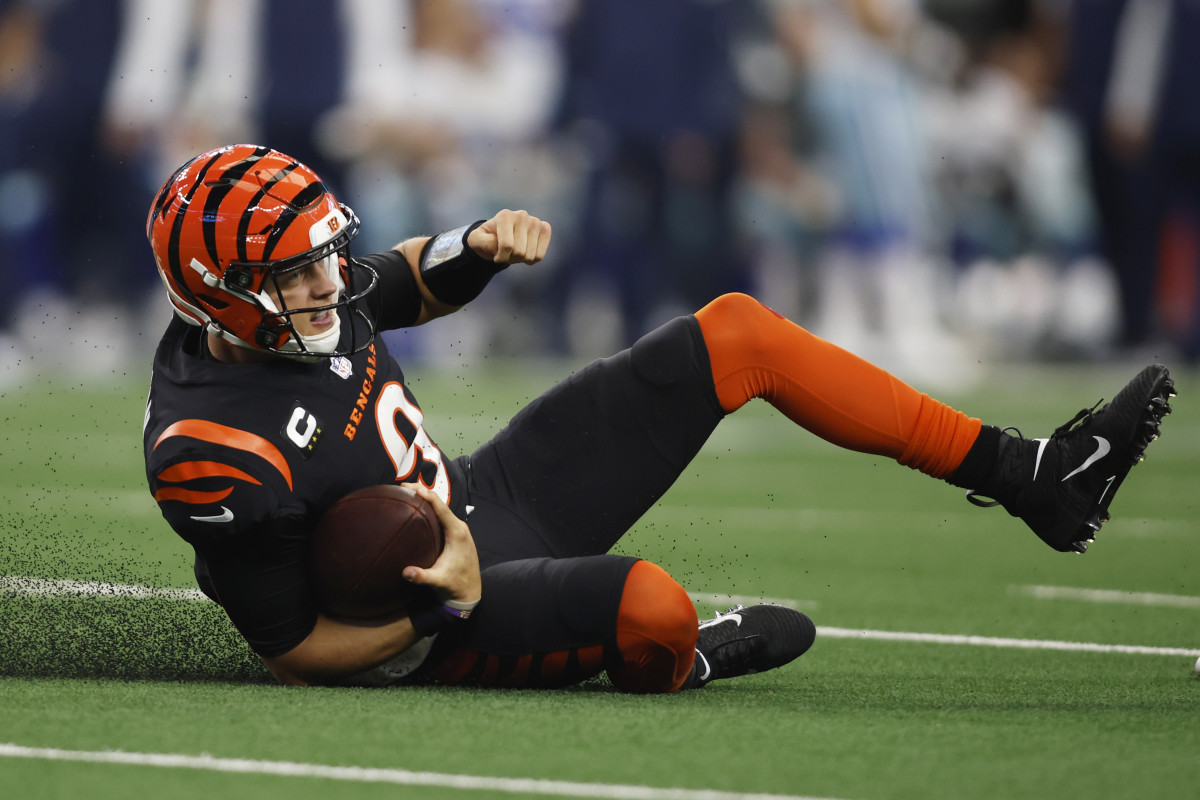
First, it’s fair to note that the Bengals have faced two of the best individual pass rushers in the NFL (T.J. Watt and Micah Parsons) over their first two weeks. By extension, they faced two of the most difficult pass rushes in the league, anchored by a pair of coaches who are able to vary their fronts and present an expansive array of looks. I took a look back at the Steelers game, especially early on, and noted that the protection problems Cincinnati was having should not be considered terminal. In the first two quarters against Pittsburgh, for example, Joe Burrow was not taking some easy throws and got himself into trouble. He’s good enough to digest these mistakes and recalibrate. On one sack, he took a lengthy, five-step drop against a seven-man pressure, which is as close to schematic sabotage as one will see in the NFL.
The Bengals’ new front five has, expectedly, struggled against odd fronts which require intimate cohesion, and that seems to be making it more difficult for Cincinnati to thrive the same way it did a year ago. In 2021, the Bengals ran 11 personnel (three wide receivers, one tight end, one running back) more than any team in the NFL, save for the Rams. So far in ’22, we’ve seen a secondary tight end used on at least 29% of their snaps in both the Pittsburgh and Dallas games. That means at least one of Cincinnati’s big three (Ja’Marr Chase, Tee Higgins, Tyler Boyd) is missing about 20% of the offensive snaps.
Burrow seems to be sensitive to the amount of protection he’s receiving via the scheme, asking the coaching staff on the sideline not to run an “empty” set on the following play during a water break. But, he’s also extending plays when he shouldn’t be.
This leads us to plays like we saw in the second quarter against Dallas on Sunday. The Bengals want to play the way they did a year ago, line up in 11 personnel and allow both the running back and the tight end to get into a route without assisting on any blocks (though, on this particular play, Joe Mixon may have just missed a chip block on Parsons, or simply didn’t get enough of him). Parsons caught right tackle La’el Collins off balance, forcing Collins to spin out into the backfield. With just a four-man pressure, Dallas instantly caved the pocket and brought Burrow down for the sack.
Our thesis here is that perhaps Burrow and coach Zac Taylor are still working out individual responsibilities for adjusting protection at the line. Meanwhile, Burrow is simultaneously getting used to life without the incredibly dependable blocking tight end C.J. Uzomah, getting acclimated to game speed again and getting used to his completely retooled offensive line. All of this is fixable.
RAIDERS
Week 1: 24–19 at L.A. Chargers
Week 2: 29–23 (OT) vs. Arizona
Time to Panic? No
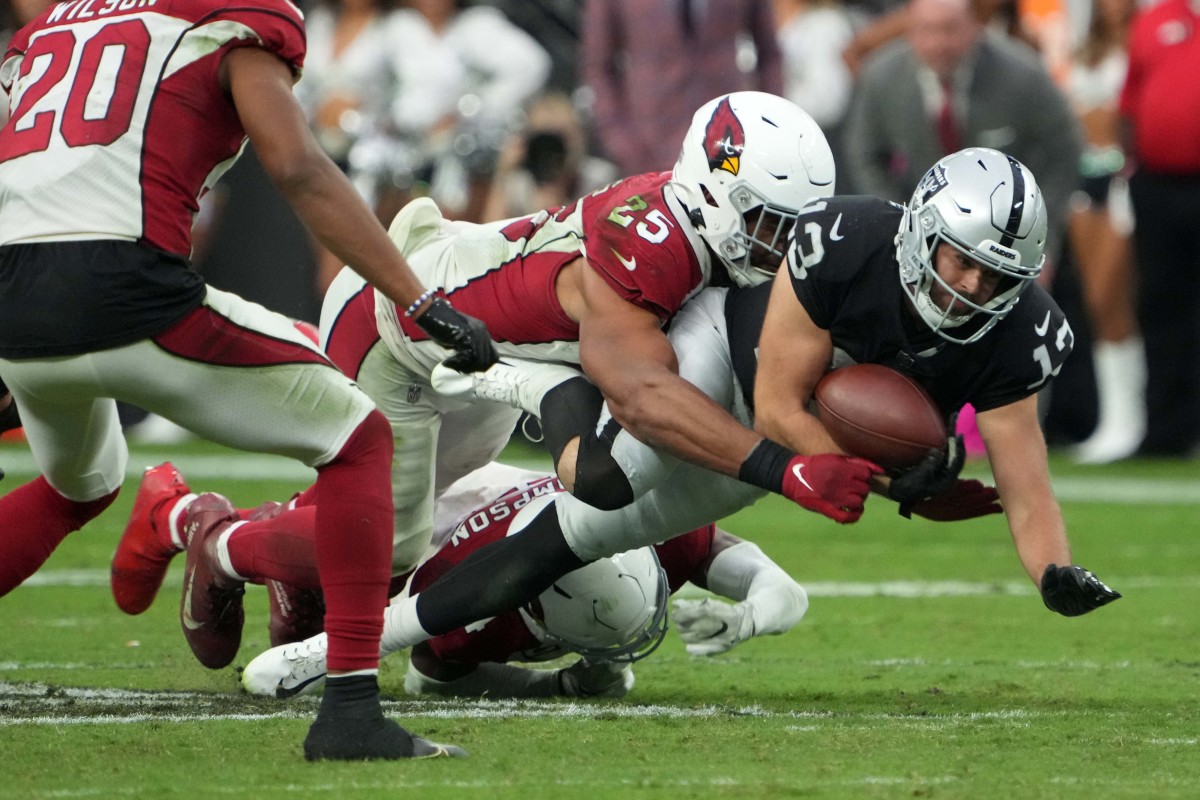
At best right now, the Raiders are a middle-of-the-road football team. They are 16th in rushing success rate, 18th in passing success rate and 23rd in expected points added per play. The latter statistic looks particularly alarming given that Las Vegas is currently being outpaced by teams featuring quarterbacks like Joe Flacco, Daniel Jones, Baker Mayfield and Marcus Mariota.
However, they lost a game against the Cardinals in which, in overtime, one of their most dependable and sure-handed wide receivers, Hunter Renfrow, fumbled the ball twice on three plays, the second resulting in Arizona’s walk-off scoop-and-score. One of the Raiders’ best pass rushers (and one of the league’s best pass rushers), Maxx Crosby, allowed Kyler Murray to elude his grasp on a critical fourth-down play in the fourth quarter. On that same play, they were flagged for defensive holding, which is symptomatic of a quarterback such as Murray being able to extend plays to an almost comical length, as he did several times on Sunday.
The underlying point: Despite playing middling football and suffering from a few thorny situations, the Raiders were in position to win against the Cardinals. They had a chance to beat the Chargers in Week 1, having the ball while trailing by less than a score in the closing minutes before Derek Carr was sacked twice. They are running the ball well (Josh Jacobs is one of the NFL’s leaders in rushing yards over expectation per carry, despite facing one of the larger percentages of eight-man boxes in the NFL) and should they be able to dictate the pace of a game; we could see them improving fairly rapidly.
Keep in mind that the Raiders are also playing up to the level of their opponents despite a complete lack of a vertical passing game. Against the Chargers, Carr was 1-of-3 with an interception on attempts beyond 20 yards and he attempted just a single throw of 20 or more yards in Week 2, which fell incomplete.
What would push us from a “Don’t panic” to a “Yes, panic!” scenario in Vegas? If Josh McDaniels isn’t able to use his conservatism to set up some deep shots to Davante Adams in the coming weeks. Then, we might start looking at the similarly plodding Patriots offense and wonder if this system has an expiration date.
COLTS
Week 1: 20–20 at Houston
Week 2: 24–0 at Jacksonville
Time to Panic? Yes
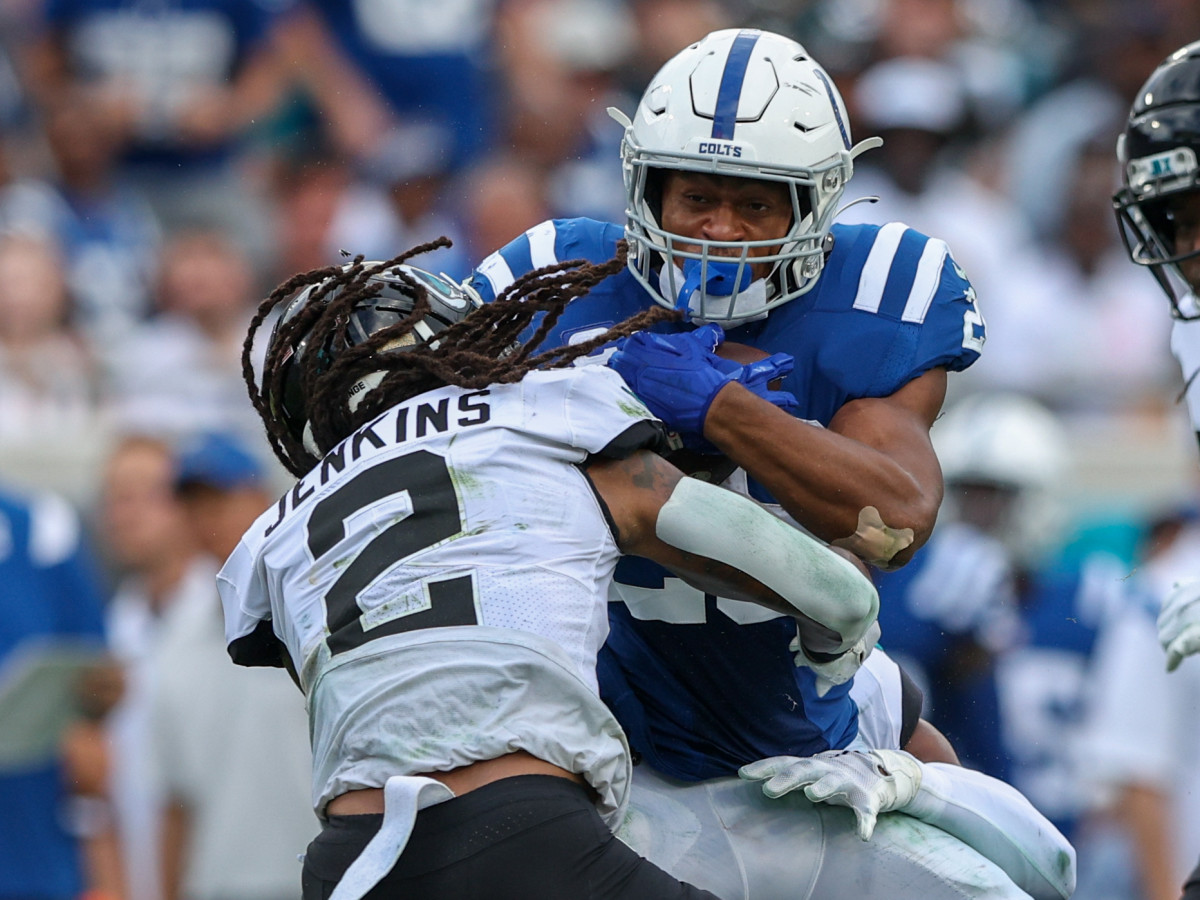
Something seems a little off with the Colts’ running game, which, without a mobile quarterback, is going to have trouble executing the kind of offense that would highlight both Matt Ryan’s accuracy and decision-making skills, and Jonathan Taylor’s athleticism and toughness. I had to rub my eyes a moment when looking at NFLGSIS statistics to see where they were focusing a majority of their ground game. At the moment, the Colts are running almost exclusively between their left guard (Quenton Nelson) and their center (Ryan Kelly). This makes sense, as they’re trusting the two most capable blockers on the team, but the disparity is somewhat concerning. During a few glimpses of the All-22 film against the Texans, we could see the backside collapsing on running plays in which the Colts were trying to extend Taylor and get him out into space behind Nelson. At times, the right side seemed to have some success, though Nelson was pulling, or Indianapolis was utilizing an unbalanced line to tilt the defense away from the right side. Both right tackle Braden Smith and right guard Danny Pinter emerged from Week 1 with one of the league’s lowest Pro Football Focus ratings at their respective positions, which, while not wholly indicative of a problem, certainly sounds an alarm bell. That’s especially true considering that Taylor is seeing eight or more defenders in the box just 7.5% of the time. That’s right: The best running back in the NFL is getting eight-man boxes less than once in every 10 snaps. By comparison, Derrick Henry in Week 1 saw a loaded box against the Giants on almost 40% of his carries.
This is all concerning because there’s not a great deal the Colts can do about it. Indy is not going to be able to turn into a zone-read team and earn cheap yards—no one is worried about Ryan taking off with the football. At the moment, Ryan does not have many downfield playmakers winning individual matchups. Against the Jaguars, according to NFL’s Next Gen Stats, none of Ryan’s top receivers earned even league-average separation. Juxtapose that with a Jets team that had four pass catchers above league average separation per pass.
TITANS
Week 1: 21–20 vs. N.Y. Giants
Week 2: 41–7 at Buffalo
Time to Panic? Maybe
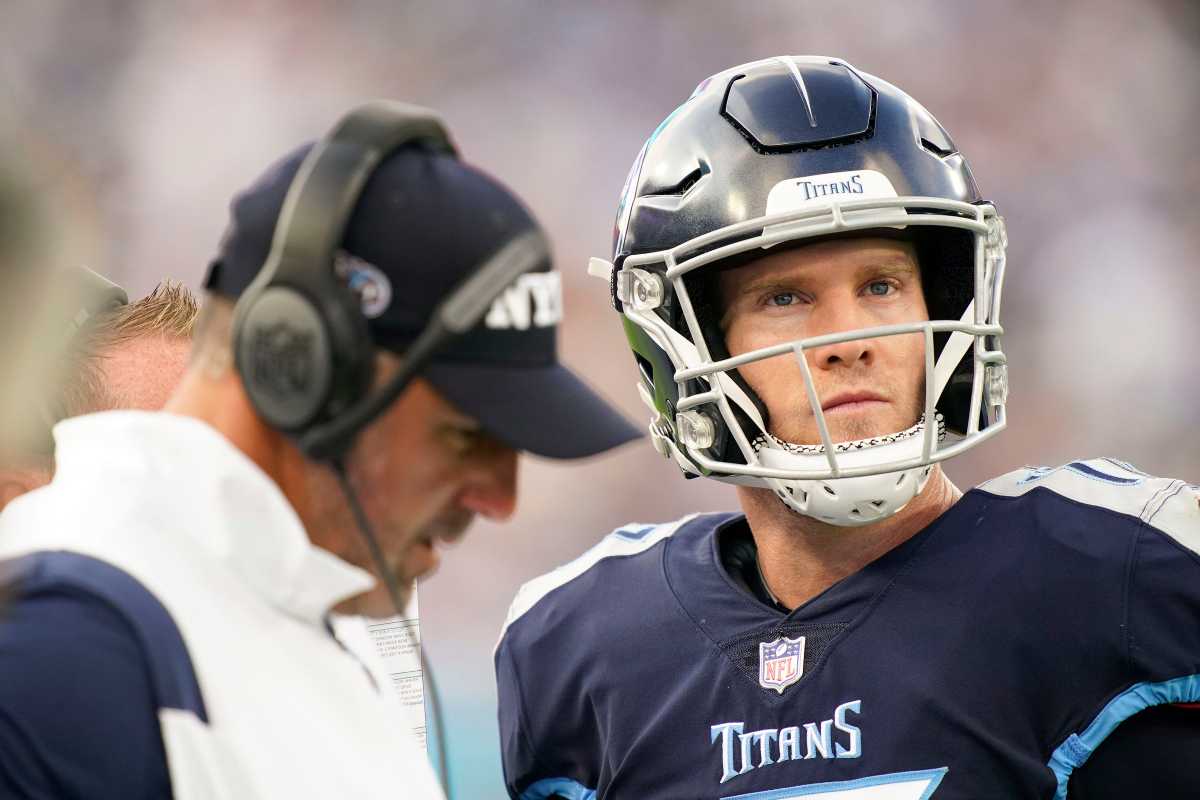
Out of principle, I’ll refrain from giving Mike Vrabel any bulletin board material. This is a team looking for an excuse to be doubted. That said, Monday Night Football in Orchard Park was ominous.
The Titans started the season by losing a close game against a surprisingly competent opponent on a missed field goal that was taken from a makeable distance. They were 6–1 last year in games decided by three points or fewer, and we could have considered the Giants loss simply a casualty of that backward luck pendulum swing. But on Monday night against the Bills—who are, again, the best team in the NFL, but one Tennessee beat head-to-head each of the last two seasons—the Titans looked like they were a minor league outfit.
Vrabel will have to answer difficult questions about Ryan Tannehill and about an offense that could be phasing its way out of usefulness. The Titans came into Monday’s game as the second-worst rushing team in the NFL after Week 1, according to the statistic EPA (expected points added) per attempt. Against the Bills, Derrick Henry ran for 1.9 yards per carry.
Without Henry operating at full speed in a classic outside-zone-style offense, Tannehill is not Tannehill. The Titans are not the Titans. This is a backward chain reaction that reverberates everywhere, even (and especially) for a defense that was on the field for a handful of 75- and 80-yard touchdown drives on Monday. I don’t think we reach When Is Malik Willis Starting? levels anytime soon (even though he took some garbage snaps Monday) but if they lose to the similarly desperate Raiders next week, it’s time to put this team under the microscope.

PANTHERS
Week 1: 26–24 vs. Cleveland
Week 2: 19–16 at N.Y. Giants
Time to Panic? Yes
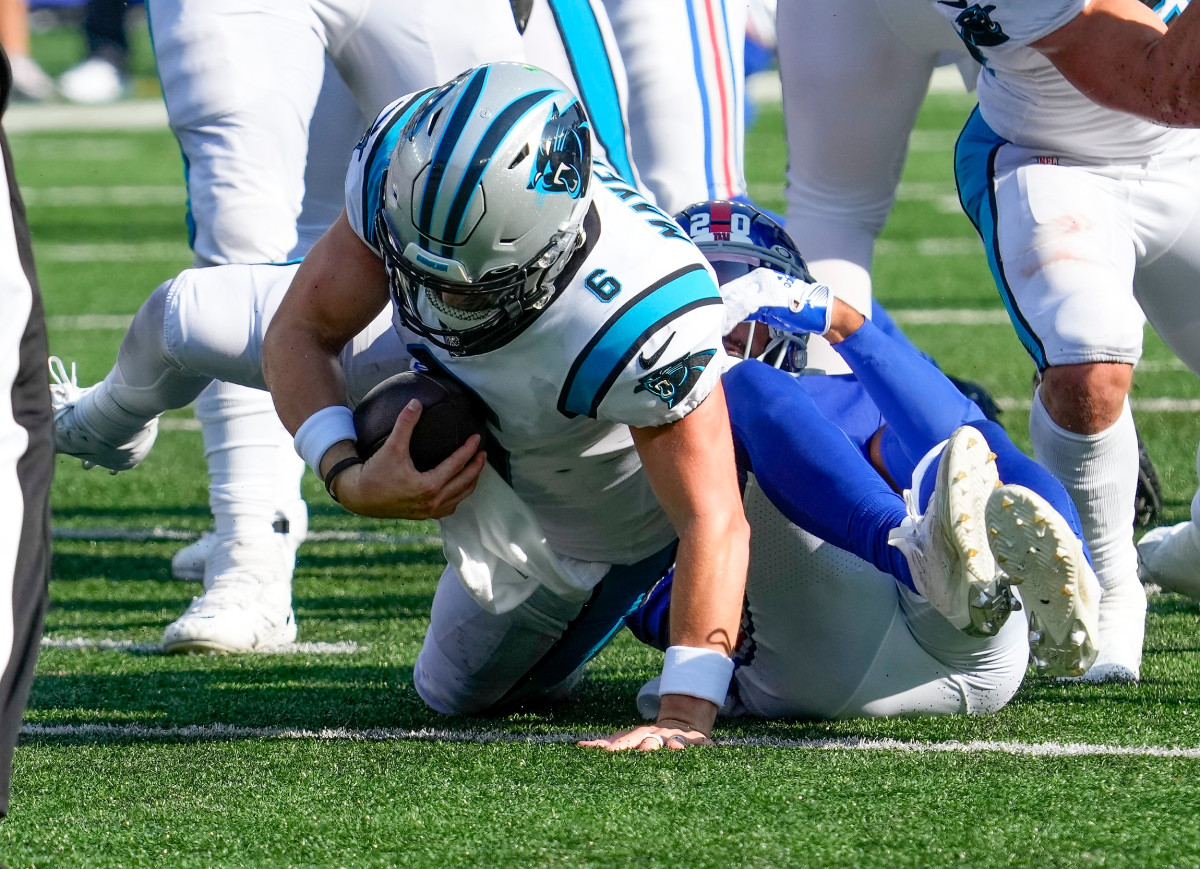
Panthers fans will (rightfully) complain that we used a lost fumble as an excuse for one team (the Raiders) and not for another. Carolina fumbled the opening kickoff, which is as potent a death knell for a team as you can have in the first 15 minutes. It gets worse when you fumble again minutes later, the second of which, by Robby Anderson, seemed more like poor ball handling than a fortuitous shot taken by a defender. While these mistakes only translated to six points, it was more than enough to represent the difference in a game that highlighted our main gripe with the Panthers: We’re not sure what, exactly, they do well.
Carolina supposedly has a really fast and responsive defense in a world where most of the quarterbacks they’ll play this season have enough mobility or a quick enough snap-to-release time to negate it. Looking back at Week 2 against the Giants, this was a game ideally suited for them to dominate, with Daniel Jones representing the NFL’s dividing line between mobile and completely immobile quarterbacks. He is just fast enough where you’d have to keep his movement skills in mind, but his tendency to hold the ball in the pocket represents some low-hanging fruit for the opposing pass rush. Weirdly, I wondered how they would have fared against the Bengals if they’d faced Cincinnati, a team with glaring protection issues, in the opener instead of the Browns and their sturdy front five, and how that might have spring-boarded them from there.
The Panthers were impressive at times against the Giants, pinning Jones behind the line of scrimmage and swarming some of the Giants’ attempts to generate a quick game (with hat tips to edge rushers Brian Burns and the instinctive Frankie Luvu), but that led to … not much in the way of complementary scoring. Sack numbers are not necessarily indicative of pressure, but the Panthers are tied with the Ravens for last in the NFL with four, despite being one of the more blitz-heavy teams in the NFL. They are second to last in the NFL with a 19% pass rush win rate, according to ESPN Stats and Info.
Even more concerning for their pass rush is the fact that they faced two of the NFL’s slowest throwers in terms of snap-to-throw time. Jones is second to last at a glacial 3.1 seconds to throw, and Jacoby Brissett is not much quicker—in large part due to all of the play-action throws he makes—at 2.9 seconds. When this team faces Tom Brady, who is getting the ball out at a mechanical 2.52 seconds per drop back, what does all their speed get them, exactly?
Not to pile on, but the Panthers are one of the highest situation-neutral passing teams in the NFL. There are carries in which Christian McCaffrey seems to be levitating for seven yards with poor pathways. Why not force the ground game a bit?
Watch NFL games live with fuboTV: Start a free trial today.
TEXANS
Week 1: 20–20 vs. Indianapolis
Week 2: 16–9 at Denver
Time to Panic? Hell no
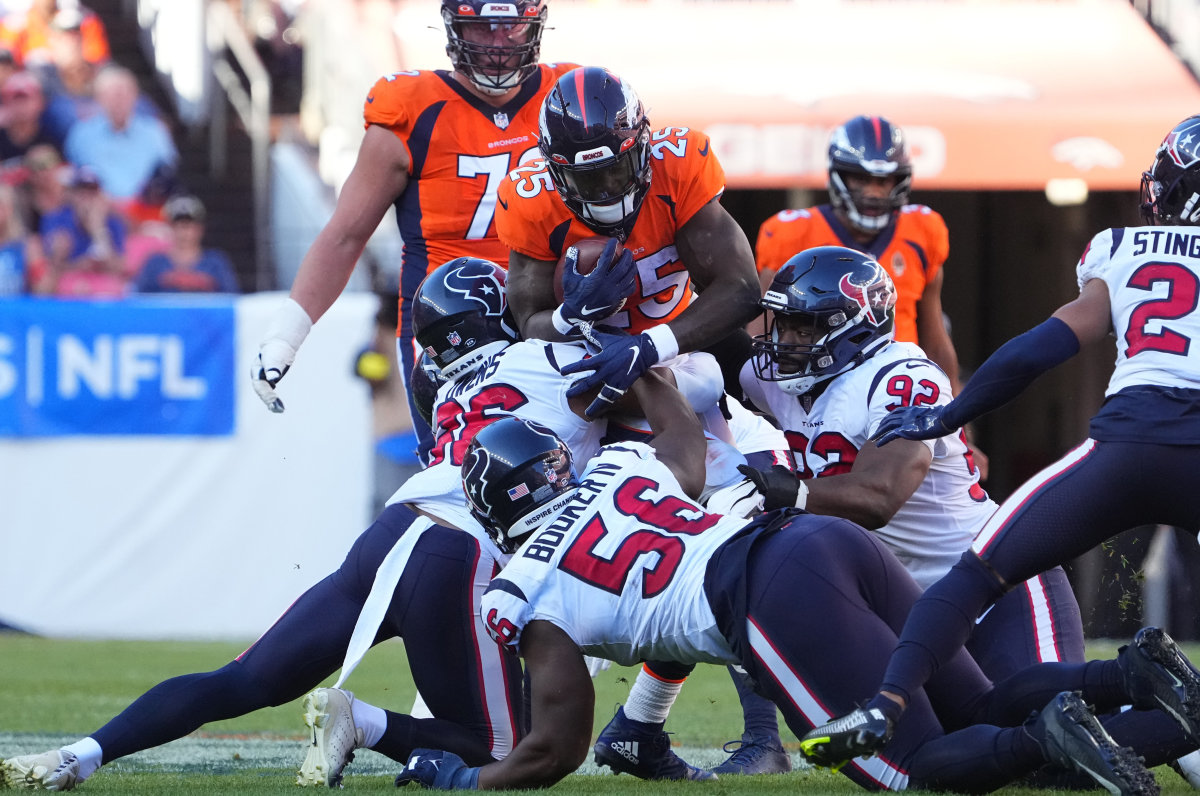
As we’ve said many times over the past few years, the Texans have a plan. We’re just not sure what it is. At the very least, we expected it to be going a whole lot worse than tying the Colts and almost beating the Broncos. While every player in the NFL has incentive to play each Sunday, it’s hard to imagine getting up for a regime that seems to be searching for a way to replace half the team in the next year. And yet, there they were tackling Jonathan Taylor collectively and aggressively in Week 1, a swarm of ants on a dropped French fry.
Watching the Texans is a bit like watching Michael Jackson moonwalk for the first time. From a technical perspective, here is someone moving backward, but with all the outer appearances of trying to move forward. On their first field goal drive against the Broncos last week, there was a play-action attempt so botched that the running back was almost throttled into Davis Mills’s lap. Later on in that same drive there was a tight-end throwback snuffed out behind the line of scrimmage. And yet, there is little quit in this team. Upfield they went, one nondescript pass at a time.
There’s no reason to panic here. Two years from now, if Houston is 0-1-1, Derek Stingley is getting routinely toasted, Davis Mills is not on the roster and Lovie Smith is still the coach? Sure, we’ll freak out. A week from now, if the Texans are still at a pass-run ratio of 38-to-18 despite Dameon Pierce in the backfield and a 50% running success rate (one of the best in the NFL), we’ll get mad. But panic? No.
FALCONS
Week 1: 27–26 vs. New Orleans
Week 2: 31–27 at L.A. Rams
Time to Panic? No
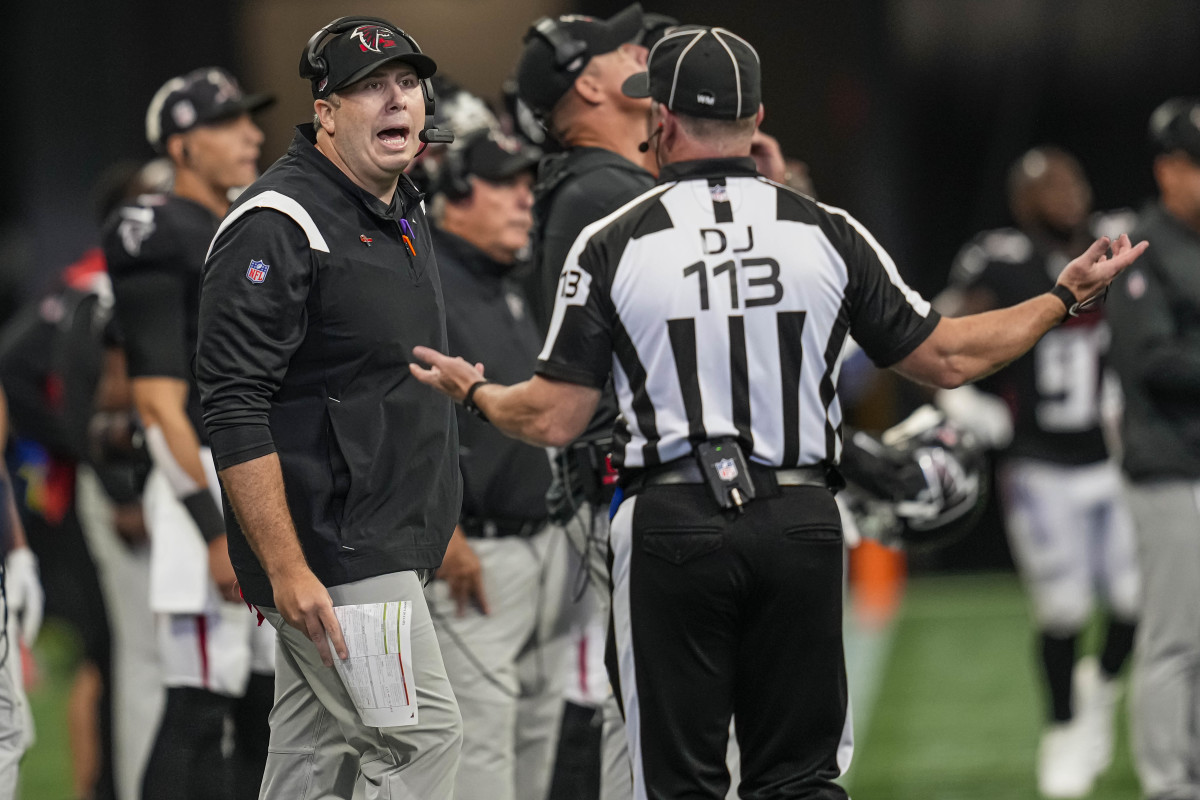
Here’s why Falcons owner Arthur Blank shouldn’t be freaking out: Coach Arthur Smith might not have press-conference finesse, but anyone who watched their Week 1 near-victory over the Saints saw an offense that was working its collective tail off. There was a lot to digest schematically and, I’d bet, a lot that will be borrowed across the NFL. Atlanta look like a weird hybrid between the Eagles, the 2021 Raiders, the Robert Griffin III-era Washington franchise and the 49ers, which is neat (even though it tailed off a bit, and they seemed less multi-dimensional against the Rams, perhaps in fear of Aaron Donald destroying their window dressings in the backfield). The tight trips formations they were using with tight ends Kyle Pitts and Parker Hesse and running back Cordarrelle Patterson was one of the coolest little wrinkles I’ve seen so far this season. They’re using pre-snap motion on almost 35% of their plays, which is one of the highest percentages in football.
They’re losing battles when they try to throw out of empty sets with no bells and whistles, leaving Marcus Mariota alone with his thoughts in the backfield.
Ultimately, if you were Arthur Blank, you’d have to ask yourself: What did I expect? This franchise has one of the worst rosters in the NFL. And yet, they nearly beat two of the best defenses in football to start the season. If the Falcons started the year with the Seahawks and Browns (their next two opponents) they very well might be 2–0.
• Tyrann Mathieu’s Return to New Orleans Is Complicated
• Can Buck and Aikman Save Monday Night Football?
• Joe Burrow and Cincinnati’s New Normal
• Gabriel Taylor Is the Late Sean Taylor’s Brother—and Maybe His Successor
